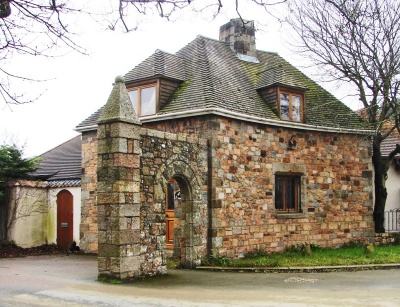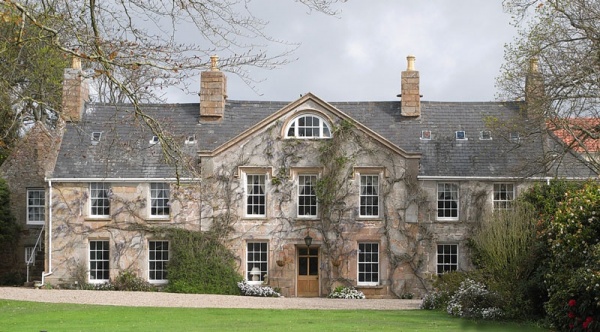Historic Jersey buildings
If you own this property, have ancestors who lived here, or can provide any further information and photographs, please contact us through editorial@jerripedia.org |
Property name
La Moye Manor
Other names
- La Moye [1]
- The Gatehouse
- La Moye Manor Cottage
- The Old House
Location
Route Orange, St Brelade
Type of property
Country mansion, not strictly a manor house. Now divided into several units
Valuations
- The Gatehouse was sold for £875,000 in 2012 and £880,000 in 2016
- 1 The Cottage was sold for £975,000 inn 2019
Families associated with the property
- Orange: It was from an early 16th century Orange heiress that the Pipons acquired, by marriage, this property. Junior branches of her family lived nearby La Moie Villa
- Pipon: Jean Pipon, the first member of the family recorded here, was Constable of St Brelade in 1551, and his grandson Richard lived here in 1560, and was also Constable in 1566. Subsequently many Pipons at La Moye were Constables and Jurats, as well as one Solicitor-General and one Attorney-General. The Fief of Noirmont was bought in 1695 by a Pipon, albeit of a different branch of the family, and a distinct Pipon family was established there.
- Le Gallais: Philippe Le Gallais (1794-1868), ancestor of the owner in the 1960s, bought the house in 1848. Formerly a solicitor in St Helier, he was a Jurat from 1843 to 1868. The house acquired its unmerited title "manor" in the late 19th century
Datestones
- ILVC ALSB 1766 - For Jean Le Vesconte and Anne Lesebirel [2], who married in St Peter in 1754 [3]
- PL ♥ EB - On a gatepost [4] The datestone register suggests that this might be for Luce and Bisson, but that is only speculation, and there are no matching marriage records. Philippe Le Brun and Elizabeth Bisson is a possibility.
Historic Environment Record entry
Listed building
House with associated outbuildings and gardens, of medieval origin with 18th century extension and 19th century alterations.
The house was occupied by German troops during World War II, who are said to have burned the original staircase balustrade. Shown on the Richmond Map of 1795.
The house has medieval origins and is unusually long for a building of this period, with two cross-walls and four chimney stacks. At right angles at the west end is a wing, containing a stone staircase, which is believed to be the rebuilt chamber block; at the other end is a small extension added in 1740. Some medieval oak timbers survive inside.
The house was re-fronted and internally altered in around 1800, and again later in the century, but various older features survive, including chamfered window surrounds, the remains of a round arch adjoining the front door (indicating the original position of the cross-passage), a corbelled granite fireplace in the entrance hall, and various medieval roof timbers.
The principal building is double-pile plan, two-storey, and seven-bay.
The site encompasses an extensive and eclectic complex of outbuildings including a refurbished coach house, walled gardens and a 16th-17th century lavoir. One of the outbuildings to the south of the house is said to have been a chapel, perhaps on account of its pointed window opening - although this is open to question as the building is aligned north-south with a fireplace on its south side.
Of particular note in the interior of the house are two 17th century (or earlier) granite fireplaces on the ground floor: a corbelled fireplace in the entrance hall, and a fireplace with stone columns in the drawing room. There is a smaller stone fireplace in the first floor west bedroom.
Other features of particular interest are the original black and white check marble tile flooring in the main hall, the stone square door cases off the main hall, a painted plank door with original ironmongery under a stone lintel in the drawing room leading to the side staircase, and stone flooring at the bottom of the staircase and along the ground floor corridor.
The Gatehouse: An unusual example of a gatehouse located in a prominent location at the entrance to La Moye Manor. Circa early 20th century, incorporating fragments of earlier structures. Small single storey gatehouse, archway and gate pillars.
Old Jersey Houses
The entry in Volume One, which makes no attempt to date the property, describes it as 'one of the most beautifully situated houses in the island, secluded and above Beau Port Bay, and surrounded by its own fields and sheltered gardens'.
- "The facade is fine but all the chamfered windows have been enlarged, bringing those on the first floor too close to the gutter for perfect proportions. The right hand shoulder stone of an arch shows that there was a round arched doorway which has since disappeared. A small wing to the west may be the oldest part, having a stone stairway and an accolade window. A small single-storey building near the house is said to have been a chapel."
The entry refers to Payne's Armorial of Jersey stating that the Pipon family held the Seigneurie of La Moye from a very early period but notes that there is no such fief.
Notes and references
- ↑ The house is not strictly a manor. It is not associated with any fief
- ↑ We have not been able to place this couple in any of our family trees. It is likely that Jean was born in St Peter in 1723, the son of Thomas
- ↑ The datestone register indicates that this inscription is on a garden gatepost at La Moye House, behind the manor
- ↑ While dates stones without initials are very common, initialled stones without a date are much more unusual

